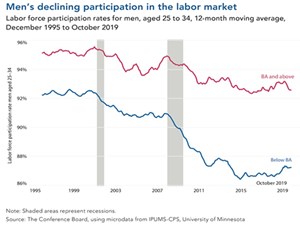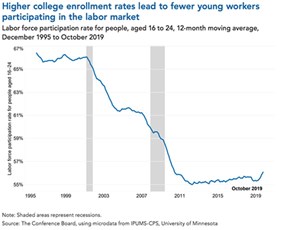Industry Labor Shortages to Continue Through 2030: Report
(UC) — Reversing the trend of recent decades, the threat of labor shortages is greater now in blue-collar and manual-services occupations than in white-collar jobs. A new study by The Conference Board explains the reasons for the trend and how some companies are adjusting to fill jobs in spite of it.
The study showed that the labor shortage affecting underground construction and other blue-collar industries is likely to continue for at least another decade.
The study describes six key trends that are making the labor shortages "more real than ever" in the 2020s. They include:
1. Working-age population growth is slowing to a halt.
The massive retirement of the large baby boomer generation is bringing growth in the working-age population to a halt—a trend that will continue through 2030. This is the main reason why this era of shortages is so different. Never before have such a large number of retirements and almost zero growth in the working-age population happened before."
2. The working-age population of noncollege graduates is already shrinking.
"As a growing share of young adults are enrolling in four-year colleges, the number of working-age people with a bachelor’s degree is solidly and uninterruptedly increasing by about 2 percent annually. On the flip side, the number without a bachelor’s degree is shrinking.
3. The recovery in labor force participation has been disappointing.
Overall, the tight labor market has led to an increase in labor force participation in recent years. But the improvement has not been remotely fast enough to prevent the labor market from tightening and has been somewhat disappointing, especially for men, and especially compared to other advanced economies in the last decade.
4. A large increase in disability rates.
An important reason for the somewhat disappointing labor force participation rates is the large increase in recent decades in the number of people not in the labor force due to disability—almost all of whom lack a college degree.
5. Compared with earlier decades, young men without a college degree are less likely to be in the labor force.
That decline in participation is partly because they are much more likely to be single, living with their parents, and have less of a need to earn income. These trends are more structural than cyclical and will be hard to reverse.
6. The large drop in labor force participation of 16-24-year-olds.
While good for society that more people in this age group are pursuing higher education, it has resulted in a steep decline in the labor force for occupations that typically hire young and less-educated workers.
The Conference Board surveyed human resources leaders at more than 200 companies to identify the impact of labor shortages and the actions they were taking to overcome them. Frequently used solutions included:
- Increasing salaries and wages: Although the most popular tactic, raising pay helps only to a point. Given increased employment opportunities for workers and the financial constraints companies face, employers must innovate to attract and retain workers.
- Increasing referrals: 51 percent of blue-collar-heavy companies indicated they had added or modified an employee referral program, compared to only 21 percent of white-collar-heavy companies.
- Ramping up social media: Increasing social media efforts ranked as the second most popular recruitment strategy (69 percent) among blue-collar-heavy companies, behind increasing wages and salaries (79 percent).
- Shortening the recruitment process: 37 percent of blue-collar-heavy companies have experienced candidates ghosting interviews. As such, the most affected companies are responding by not requiring multiple interviews.
- Extending outreach beyond the usual recruits: 55 percent of blue-collar-heavy companies ranked expanding the target demographic as a key tactic; just 30 percent of white-collar-heavy companies said the same.
A potential blind spot, the study showed, is that some companies are not doing enough to retain mature workers. The lowest-ranked retention strategy was providing new incentives to retain older workers in full or partial capacity.
The full report is available for free download at: https://www.conference-board.org/topics/labor-shortages.
Related News
From Archive

- Glenfarne Alaska LNG targets late-2026 construction start for 807-mile pipeline project
- U.S. water reuse boom to fuel $47 billion in infrastructure spending through 2035
- $2.3 billion approved to construct 236-mile Texas-to-Gulf gas pipeline
- Major water pipe break in Puerto Rico hits over 165,000 customers
- Potomac River Tunnel project enters construction phase beneath Washington, D.C.
- Pennsylvania American Water launches interactive map to identify, replace lead water service lines
- Trump's tariffs drive $33 million cost increase for Cincinnati sewer project
- Utah city launches historic $70 million tunnel project using box jacking under active rail line
- Tulsa residents warned after sewer lines damaged by boring work
- Fatal trench collapse halts sewer construction in Massachusetts; two workers hospitalized





Comments